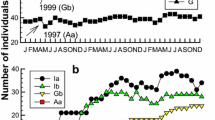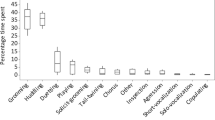Abstract
The social aspects of primate reintroduction are of primary importance to the success of release programs and need to be assessed through the study of changes in social behavior over time. This study reports on the development of social structure and organization in a community of 37 chimpanzees (Pan troglodytes troglodytes) released into the wild in the Conkouati Douli National Park, Republic of Congo. Analyses of post-release monitoring data collected over 10 years on association patterns between individuals show that during the years following individual releases, chimpanzees exhibited changing social structure and organization until they stabilized in one community living in a fission–fusion system. Social organization development was directly affected by several factors including community size and experience in the wild, while social structure was affected by individual characteristics: gender, pre-release history, and release history. Similarities between social structure and organization observed in the released community and wild chimpanzee communities demonstrate that the release program is a success from a social point of view.




Similar content being viewed by others
References
Basabose AK (2002) Diet composition of chimpanzees inhabiting the montane forest of Kahuzi, Democratic Republic of Congo. Am J Primatol 58:1–21
Beck BB, Castro MI, Stoinski TS, Ballou J (2002) The effects of pre-release environments on survivorship in golden lion tamarins. In: Kleimlan DG, Rylands A (eds) The Lion Tamarins: twenty-five years of research and conservation. Smithsonian Institution Press, Washington DC
Beck B, Walkup K, Rodrigues M, Unwin S, Travis D, Stoinski T (2007) Best practice guidelines for re-introduction of great apes. SSC Primate Specialist Group of the World Conservation Union, Gland, p 48
Boesch C (1991) The effects of leopard predation on grouping patterns in forest chimpanzees. Behaviour 117:221–242
Boesch C (1996) Social grouping in Taï chimpanzees. In: McGrew WC (ed) Great ape societies. Cambridge University Press, Cambridge, pp 101–113
Borner M (1985) The rehabilitated chimpanzees of Rudongo Island. Oryx 19:151–154
Brewer S (1978) The chimpanzees of Mt Assirik. Alfred A. Knopf, New York, pp 293–295
Britt A, Lambana BR (2003) Can captive-bred Varecia variegate variegate adapt to a natural diet on release to the wild? Int J Primatol 24:987–1005
Carpenter M, Tomasello M, Savagerumbaugh S (1995) Joint attention and imitative learning in children, chimpanzees, and enculturated chimpanzees. Soc Dev 4:217–237
Chapman CA (1990) Association patterns of spider monkeys—the influence of ecology and sex on social-organization. Behav Ecol Sociobiol 26:409–414
Chapman CA, Wrangham RW (1993) Range use of the forest chimpanzees of Kibale—implications for the understanding of chimpanzee social-organization. Am J Primatol 31:263–273
Chapman CA, Wrangham RW, Chapman LJ (1995) Ecological constraints on group-size—an analysis of spider monkey and chimpanzee subgroups. Behav Ecol Sociobiol 36:59–70
Clutton-Brock TH, Harvey PH (1977) Primate ecology and social organization. J Zool 183:1–39
Coelho AM, Bramblett CA, Quick LB (2005) Social organization and food resource availability in primates: A socio-bioenergetic analysis of diet and disease hypotheses. Am J Phys Anthropol 46:253–264
Conradt L, Roper TJ (2000) Activity synchrony and social cohesion: a fission-fusion model. Proc R Soc B: Biol Sci 267:2213–2218
Couzin ID (2006) Behavioral ecology: Social organization in fission–fusion societies. Curr Biol 16:169–171
Custance DM, Whiten A, Fredman T (2002) Social learning and primate reintroduction. Int J Primatol 23:479–499
Deputte BL, Quris R (1996) Socialization processes in primates: use of multivariate analyses .1. Application to social development of captive mangabeys. Behav Process 36:1635-1651
Doumenge C (1992) La réserve de Conkouati, Congo. Le secteur sud-ouest. World Conservation Union, Gland
Dunham KM (1999) The social organization of mountain gazelles Gazella gazella in a population reintroduced to central Arabia. J Arid Environ 43:251–266
Gagneux P, Boesch C, Woodruff DF (1999) Female reproductive strategies, paternity and community structure in wild West African chimpanzees. Anim Behav 57:19–32
Goodall J (1986) The chimpanzees of Gombe: patterns of behavior. Harvard University Press, Cambridge
Goossens B, Setchell JM, Tchidongo E, Dilambaka E, Vidal C, Ancrenaz M, Jamart A (2005) Survival, interactions with conspecifics and reproduction in 37 chimpanzees released into the wild. Biol Conserv 123:461–475
Griffith B, Scott JM, Carpenter JW, Reed C (1989) Translocation as a species conservation tool: status and strategy. Science 245:477–480
Hannah A, McGrew W (1991) Rehabilitation of captive chimpanzees. In: Box H (ed) Primate responses to environmental change. Chapman and Hall, London, pp 167–186
Hashimoto C, Furuichi T, Tashiro Y (2001) What factors affect the size of chimpanzee parties in the Kalinzu Forest, Uganda? Examination of fruit abundance and number of estrous females. Int J Primatol 22:947–959
Hladik CM (1973) Alimentation et activité d’un groupe de chimpanzés réintroduits en forêt gabonaise. La Terre et la Vie 27:343–413
Hecketsweiler P, Mokoko Iconga J (1991) La réserve de Conkouati, Congo. Le secteur sud-est. World Conservation Union, Gland
Holm S (1979) A simple sequential rejective multiple test procedure. Scand J Stat 6:65–70
IUCN (1998) Guidelines for re-introductions. IUCN/SSC Re-introduction Specialist Group, Gland
Kappeler M, van Schaik CP (2002) Evolution of primate social systems. Int J Primatol 23:707–740
Kutsukake N (2006) The context and quality of social relationships affect vigilance behaviour in wild chimpanzees. Ethology 112:581–591
Lehmann J, Boesch C (2004) To fission or to fusion: effects of community size on wild chimpanzee (Pan troglodytes verus) social organization. Behav Ecol Sociobiol 56:207–216
Matsumoto-Oda A (1999) Mahale chimpanzees: grouping patterns and cycling females. Am J Primatol 47:197–207
Matsumoto-Oda A, Hosaka K, Huffman MA, Kawanaka K (1998) Factors affecting party size in chimpanzees of the Mahale mountains. Int J Primatol 19:999–1011
Mcfarland D (2006) Dictionary of animal behavior. Oxford University Press, USA
Mitani JC, Amsler SJ (2003) Social and spatial aspects of male subgrouping in a community of wild chimpanzees. Behaviour 140:869–884
Mitani JC, Watts DP (2005) Correlates of territorial boundary patrol behaviour in wild chimpanzees. Anim Behav 70:1079–1086
Mitani JC, Merriwether DA, Zhang CB (2000) Male affiliation, cooperation and kinship in wild chimpanzees. Anim Behav 59:885–893
Mitani JC, Watts D, Pepper J, Merriwether DA (2002) Demographic and social constraints on male chimpanzee behaviour. Anim Behav 64:727–737
Nakamura M (2003) ‘Gatherings’ of social grooming among wild chimpanzees: implications for evolution of sociality. J Hum Evol 44:59–71
Newton-Fisher NE (1999a) Association by male chimpanzees: a social tactic? Behaviour 136:705–730
Newton-Fisher NE (1999b) The diet of chimpanzees in the Budongo Forest Reserve, Uganda. Afr J Ecol 37:344–354
Neswton-Fisher NE, Reynolds V, Plumptre AJ (2000) Food supply and chimpanzees (Pan troglodytes schweinfurthii) party size in the Budongo Forest Reserve, Uganda. Int J Primatol 21:613–628
Nishida T (1968) The social group of wild chimpanzees of the Mahale Mountains. Primates 9:167–224
Nishida T (1987) Local traditions and cultural transmission. In: Smutts BB, Cheney DL, Seyfarth RM, Wrangham RW, Struhsaker TT (eds) Primate societies. The University of Chicago Press, Chicago, pp 462–474
Pepper JW, Mitani JC, Watts DP (1999) General gregariousness and specific social preferences among wild chimpanzees. Int J Primatol 20:613–632
Poirier FE, Hussey LK (1982) Nonhuman primate learning: the importance of learning from an evolutionary perspective. Anthropol Educ Quart 13:133–148
Ramos-Fernandez G, Boyer D, Gomez VP (2006) A complex social structure with fission–fusion properties can emerge from a simple foraging model. Behav Ecol and Sociobiol 60:536–549
Rubenstein DI, Wrangham RW (1986) Ecological aspects of social evolution: birds and mammals. Princetown University Press, New York
Sakura O (1994) Factors affecting party size and composition of chimpanzees (Pan troglodytes verus) at Bossou, Guinea. Int J Primatol 15:167–183
Shier DM, Owings DH (2007) Effects of social learning on predator training and postrelease survival in juvenile black-tailed prairie dogs, Cynomys ludovicianus. Anim Behav 73:567–577
Stoinski TS, Beck BB, Bloomsmith MA, Mapple TL (2003) A behavioural comparison of captive-born, reintroduced golden lion tamarins and their wild-born offspring. Behaviour 140:137–160
Sugiyama Y, Koman J (1979) Social structure and dynamics of wild chimpanzees at Bossou, Guinea. Primates 20:323–339
Tear TH, Ables ED (1999) Social system development and variability in a reintroduced Arabian oryx population. Biol Conserv 89:199–207
Treves A, Naughton-Treves L (1997) Case study of a chimpanzee recovered from poachers and temporarily released with wild conspecifics. Primates 38:315–324
Tutin CEG, McGrew WC, Baldwin PJ (1983) Social organization of savanna-dwelling chimpanzees, Pan troglodytes verus, at Mt. Assirik, Senegal. Primates 24:154–173
Tutin CEG, Ancrenaz M, Paredes J, Vacher-Vallas M, Vidal C, Goosens B, Bruford MW, Jamart A (2001) Conservation biology framework for the release of wild-born orphaned chimpanzees into the Conkouati Reserve, Congo. Conserv Biol 15:1247–1257
vanDierendonck MC, Bandi N, Batdorj D, Dugerlham S, Munkhtsog B (1996) Behavioural observations of reintroduced Takhi or Przewalski horses (Equuq ferus przevalskii) in Mongolia. Appl Anim Behav Sci 50:95–114
Whiten A, Spiteri A, Horner V, Bonnie KE, Lambeth SP, Schapiro SJ, de Waal FBM (2007) Transmission of multiple traditions within and between Chimpanzee groups. Curr Biol 17:1038–1043
Whitehead H (1997) Analysing animal social structure. Anim Behav 53:1053–1067
Williams JM, Pusey AE, Carlis JV, Farm BP, Goodall J (2002) Female competition and male territorial behaviour influence female chimpanzees' ranging patterns. Anim Behav 63:347–360
Wilson EO (2000) Sociobiology. Harvard University Press, Cambridge
Wilson ML, Hauser MD, Wrangham RW (2001) Does participation in intergroup conflict depend on numerical assessment, range location, or rank for wild chimpanzees? Anim Behav 61:1203–1216
Wrangham RW, Cheney DL (1985) Predation rates and social-structure in primates. Am J Primatol 8:372–372
Yukimaru S, Jeremy K (1979) Social structure and dynamics of wild chimpanzees at Bossou, Guinea. Primates 20:323–339
Acknowledgements
We are grateful to Caroline Ross, Peter Shaw, Ann McLarnon, Stuart Semple, Mary Mackenzie, Joanna Setchell, and to the members of H.E.L.P. International for their support. We also thank the Ministry of Forest Economy and Environment of the Republic of Congo and Mr. Grégoire Bonassidi (Conservateur of the CDNP) for permission to carry out our research in the CDNP. We are grateful for financial support from the US Fish and Wildlife Service, Cleveland Zoological Society, Columbus Zoo and Aquarium, International Primate Protection League, Arcus Foundation, Pan African Sanctuary Alliance, Tusk Trust, Sea World and Busch Gardens, Disney Wildlife Conservation Fund, American Zoos Association, Fondation Brigitte Bardot, Fondation Bourdon, Société Protectrice des Animaux, One Voice, Beauval Zoo, Amneville Zoo, La Barben Zoo, Gorilla, Cardiff University, and Roehampton University. Finally, we would like to thank the H.E.L.P. Congo field assistants for their continuing hard work in monitoring the released chimpanzees.
Author information
Authors and Affiliations
Corresponding author
Additional information
Communicated by D. Watts
Rights and permissions
About this article
Cite this article
Le Hellaye, Y., Goossens, B., Jamart, A. et al. Acquisition of fission–fusion social organization in a chimpanzee (Pan troglodytes troglodytes) community released into the wild. Behav Ecol Sociobiol 64, 349–360 (2010). https://doi.org/10.1007/s00265-009-0851-1
Received:
Revised:
Accepted:
Published:
Issue Date:
DOI: https://doi.org/10.1007/s00265-009-0851-1




